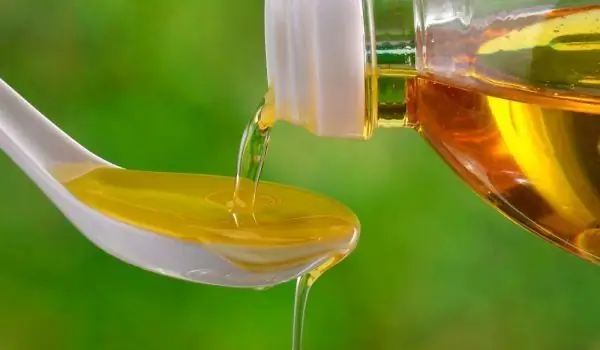2025 Author: Jasmine Walkman | [email protected]. Last modified: 2025-01-23 10:18
Castor oil is a product derived from the seeds of the plant Ricin (Ricinus communis), also known as a tick because of its Latin name, which means exactly a tick. Ricin belongs to the Mlechkovi family, and it is the main representative of the genus Ricin. Many experts are of the opinion that he is the only member of the genus.
Ricina is called a "tick" because there is a great similarity between the shape of the seed and the shape of a blood-soaked tick. The plant itself originates from East Africa, where it has been cultivated since ancient times. Today ricin is grown as a technical crop in all parts of the world with a temperate climate because of the useful Castor oil. It also has a lot of side applications, and recently entered the production of biodiesel.
The cultivation of castor oil dates back to time immemorial, and evidence of its use has been found in ancient Egyptian tombs from about 4000 BC. The extracted castor oil was then used for lighting. Even Herodotus mentions ricin as "kiki" and claims that his homeland is Egypt. Information about how castor oil was used for lighting is given by Strabo - it was used in oil lamps and ointments.
A detailed description of the plant itself is given by Theophrastus and Dioscorides, the latter of which gives comprehensive information about the process of extracting the oil and its application as a laxative. With its fame as a strong laxative, castor oil has gained a place in the works of Pliny.
The people of ancient Rome knew the tree of Ricina under the name of Christ's palm or the Palm of Christ, which has survived to this day. This plant was known for its beneficial properties even to the Palicuri Indians in Guyana, who used it for external floating after a long illness with a high temperature. Of course, even then people were well aware of the poisonous power of castor oil.
Apart from being a technical crop, castor is often used as an ornamental plant, because its flowers are extremely beautiful, colored in different colors - purple-black, red, green, bronze, etc. As an ornamental plant, ricin was widely used in Bulgaria until the mid-1930s. Then it began to be grown as an oil crop, with plantations reaching 100,000 acres by the mid-1950s.
Composition of castor oil
Castor itself is a poisonous plant that kills all farm animals that have consumed it. Ricin poisoning is very severe, affecting all organs and systems of animals. The poisonous substances in the composition of the plant are the poisonous protein ricin and the alkaloid ricinin. However, valuable castor seeds contain between 45-60% castor oil. In appearance, the seeds resemble those of beans, but there are significant differences between them. Consumption of castor seeds leads to severe poisoning.
Storage of castor oil
Store castor oil in a dry and cool place. Avoid direct sunlight.

Use of castor oil
With internal use, castor oil is mostly used as a laxative. Its use should be very careful and according to the instructions on the package, because otherwise there may be unwanted side effects and reactions.
How to use:
For adults, the internal intake is 1-2 tablespoons. daily (15-30 years), and for children over 6 years of age - 1-3 tsp. daily. To dull the taste of castor oil, you can consume it with fruit juice or sweetened with a little honey or sugar drinks such as coffee and tea. The combination with honey should be in a ratio of 1: 1. You can treat the oil directly on the back half of the tongue. The relaxing effect of castor oil occurs after about 2-6 hours.
Benefits of castor oil
Castor oil has proven anti-inflammatory, analgesic, antiviral and antibacterial properties. As a laxative, it has a cleansing effect on the body, and at the same time strengthens the immune system. Constipation can be avoided with castor oil. For children, the recommended dose is a few drops to 1 tsp. daily for a period not longer than 3 days. In lazy intestines, treatment can be repeated only after a few days of rest. In adults, there should also be a break of a few days before taking castor oil again after the first session.
To ward off the flu and cold, mix 1 tbsp. castor oil with 10 drops of peppermint or lavender oil. Drop a few drops on the tongue and wait for them to dissolve in the saliva, then you can swallow. Repeat the procedure several times for 1 day. Even hay fever can be treated well with castor oil, and every morning you can drip 1 drop in each nostril and 2-3 drops on the tongue. Hold for 1 minute and swallow. Infectious rhinopharyngitis can have a positive effect on the same scheme.
If you have joint pain, especially those of the arms and legs, treat the affected areas of the skin with warm castor oil in the morning and evening with gentle massage movements. Castor oil-soaked feet are worn in the evening with warm socks made of natural fabric and sleep with them. Massage with the oil and the spine, then go to bed wearing a woolen blouse.

Castor oil has also been shown to be useful for conjunctivitis (one drop in each eye the night before bed and barley (a compress with castor oil for the night. If you lubricate the warts with healing oil, they will also have a good effect. (1 tsp.) and apply a bandage and leave until the wart is removed.
Castor oil can also help if you have otitis (a few drops of slightly warmed castor oil are inserted into the ear canal and plugged with a tampon. Massage the neck lightly from the bottom up to the ear, which will facilitate the drainage of lymph. In the same way castor oil can also be used for tinnitus and tinnitus. The oil is also useful against hemorrhoids, making a compress on the formations, which is left to act overnight.
Beautification with castor oil
Along with the health benefits castor oil can help maintain the beautiful appearance of your skin, hair and nails. As already mentioned, rubbing castor oil on warts helps to erase them. The same applies to purulent wounds and various irritated areas of the skin. Castor oil can also be treated on the navel of a newborn who does not want to go home quickly. To protect your skin from drying out during the winter months, mix 10 drops of castor oil with one egg yolk and apply in a thin layer on the face. Leave on for 15 minutes and remove with a decoction of chamomile.
If you turn on Castor oil in hair masks, the positive effect is certain. You can apply only the oil directly on the scalp by rubbing in the evening before bed 2 times in 1 week. In the morning, wash the oil from your head and hair with a mild shampoo. You can relieve calluses and various types of wounds with castor oil. Proven castor oil removes age spots on the skin and hands. It also works quite well on cracked heels, and should be applied again twice a week before bedtime. Treat your lashes and eyebrows with a small amount of castor oil if you want to make them thicker and give a healthy look to the hair.
Harm from castor oil
The use of Castor oil it should be controlled and moderate, especially if used as a laxative. Prolonged use of the oil can cause the intestines to lose their normal peristalsis and become addictive. Do not take castor oil with fat-soluble substances (benzene, organophosphorus compounds, etc.) and male fern extract. It is contraindicated to use the oil for hemorrhoidal bleeding, peritonitis, appendicitis, ulcerative enterocolitis, acute cholecystitis, constipation due to mechanical obstacles, such as ileus, incarcerated hernia and others.
Do not use castor oil during your menstrual period, with high fever, chronic constipation and jaundice, chronic constipation and acute and chronic kidney disease. If you have stomach pain or nausea, do not take castor oil unless prescribed by a doctor. Castor oil delays the absorption of fat-soluble vitamins in the body. Castor oil is contraindicated for ingestion during pregnancy.
Side effects
When used internally Castor oil Allergic side effects may occur. In addition to prolonged use of the product can make the body get used to it, castor oil can cause nausea, vomiting, colic and quite severe diarrhea. If a larger dose of the oil comes into contact with the eyes, it is very likely to cause irritation.
Recommended:
How To Store Olive Oil And Vegetable Oil

The oil is stored quite a long time thanks to its factory packaging. It is sold with a tightly closed lid and thanks to this it can retain its qualities for two years. Oil bottles should be stored in a cool dark place. It is better to store oil that is sealed in glass rather than plastic bottles.
Okra Oil Replaces Coconut Oil

Okra (Abelmoschus esculentus, Hibiscus esculentus) is an annual herbaceous plant, reaching a height of nearly one meter. The use of okra is broad-spectrum. The fruits can be eaten fresh or dried and added to various dishes, soups or sauces.
Olive Oil Versus Rapeseed Oil: Which Is Healthier?

Rapeseed oil and olive oil are two of the most popular cooking oils in the world. Both are touted as heart healthy. However, some people wonder what the difference is and what is healthier. What is rapeseed and olive oil? Rapeseed oil is produced from rapeseed (Brassica napus L.
Castor: Corn Oil Was More Useful Than Olive Oil

Corn oil is proving to be more valuable for health than the olive oil, which is said to be the most useful fat, reports Eurek Alert. Corn oil lowers cholesterol levels more successfully than cold-pressed olive oil, say researchers who conducted the study.
Why Is It Good To Replace Oil With Olive Oil?

Increasingly, nutritionists and all other health professionals recommend that we stop using oil and replace it entirely with olive oil. Unfortunately, the price of olive oil is much higher than that of ordinary oil, and for this purpose we need to find out if this is really necessary.

